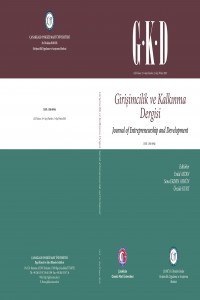GİRİŞİMCİLİK NİYETİ, ÖZ-YETERLİLİK VE GİRİŞİMCİLİK POTANSİYELİNE ÇEVRENİN ETKİSİ SAĞLIK YÖNETİMİ LİSANSÜSTÜ ÖĞRENCİLERİ ÜZERİNE BİR ARAŞTIRMA
Öz
Girişimciliğin yaygınlaşması bireylerin girişimcilik niyetinin geliştirilmesi, girişimcilik öz-yeterliliğinin arttırılması, özellikle gençlerin çevrelerinin girişimciliğe yönlendirmeleri, onları bir girişimci olmaları yönünde özendirmeleri ve teşvik etmeleri ile gerçekleşmektedir. Yapılan araştırmalar sağlık çalışanı ve öğrencilerinin kendi çalışma alanlarında veya yeni bir alanda girişimci olma yönünde bir potansiyellerinin olmadığını göstermektedir. Bu çerçevede sağlık çalışanlarının girişimciliğe teşvik edilmeleri gerektiği anlaşılmaktadır. Çalışmamızın amacı; sağlık sektöründe çalışan ve/veya çalışmak isteyen sağlık yönetimi yüksek lisans eğitimi alan öğrencilerin girişimcilik niyetine bağlı olarak öz-yeterlilik, girişimcilik potansiyeli üzerinde çevrenin etkisini araştırmaktadır. Araştırma sonuçlarına göre; Girişimcilik niyeti, öz-yeterliliği, potansiyeli ve çevrenin etkisi 4 boyutta açıklanmaktadır. Bu boyutlar girişimcilik niyeti (GNYT) faktörü, girişimcilik öz-yeterliliği (GÖZYET) faktörü, Girişimcilik potansiyeli (GPOT) ve çevre faktörü (CEVRE) adıyla tanımlanmıştır. Doğrulayıcı faktör analizi ile araştırma faktör yapısı doğrulanmıştır. Cinsiyet, eğitim durumu, çalışma alanı, bir kamu kurumuna atanma veya atanmama durumu değişkenleri ile araştırma faktörlerinin farklılaşma durumu tespit edilmiştir. Ancak araştırmamızda çevrenin sağlık öğrencilerinin girişimcilik niyeti üzerine etkisi, öğrencilerin girişimcilik potansiyeli ve girişimcilik öz yeterliliği aracılığıyla etkili olduğu ortaya çıkmıştır.
Anahtar Kelimeler
Kaynakça
- AWOGBENLE, A. C., & IWUAMADI, K. C. (2010). Youth Unemployment: Entrepreneurship Development Programme As An Intervention Mechanism. African Journal Of Business Management, 4(6), 831-835.
- AYTAÇ, Ö. (2006). Girişimcilik: Sosyo-Kültürel Bir Perspektif. Dumlupınar Üniversitesi Sosyal Bilimler Dergisi, (15), 139-160
- BALABAN, Ö., & ÖZDEMİR, Y. (2008). Girişimcilik Eğitiminin Girişimcilik Eğilimi Üzerindeki Etkisi: Sakarya Üniversitesi İİBF Örneği.
- BOORE, J., & PORTER, S. (2011). Education For Entrepreneurship İn Nursing. Nurse Education Today, 31(2), 184-191.
- CREDE, M., & HARMS, P. (2019). Questionable Research Practices When Using Confirmatory Factor Analysis. Journal Of Managerial Psychology. 34(1),18-30
- ÇELİK, A., İNCE, M., & BOZYİĞİT, S. (2014). Üniversite Öğrencilerinin Girişimcilik Niyetlerini Etkileyen Ailesel Faktörleri Belirlemeye Yönelik Bir Çalışma. Ömer Halisdemir Üniversitesi İktisadi Ve İdari Bilimler Fakültesi Dergisi, 7(3), 113-124.
- DEAKINS, D., FREEL, M. S., & MASON, K. (1999). Entrepreneurship And Small Firms.1-6
- EL HARBI, S., & ANDERSON, A. R. (2010). Institutions And The Shaping Of Different Forms Of Entrepreneurship. The Journal Of Socio-Economics, 39(3), 436-444
- FARIA, J. R. (2015). Entrepreneurship And Business Cycles: Technological Innovations And Unemployment. International Entrepreneurship And Management Journal, 11(2), 253-265.
- GARAVAN, T. N., & BARRA, O. (1994). Entrepreneurship Education and Training Programmes. Journal of European İndustrial Training.18(11), 13-21
- GARTNER, W. B. (1990). What Are We Talking About When We Talk About Entrepreneurship?. Journal of Business Venturing, 5(1), 15-28.
- GUO, K. L. (2003). Applying entrepreneurship to health care organizations. New England Journal of Entrepreneurship, 6(1), 8.
- HOYLE, R. H. (1995). The Structural Equation Modeling Approach: Basic Concepts And Fundamental İssues. In Structural Equation Modeling: Concepts, İssues, And Applications, R. H. Hoyle (Editor). Thousand Oaks, CA: Sage Publications, Inc., 1-15.
- JOHNSON, D. (2001). What is Innovation And Entrepreneurship? Lessons For Larger Organisations. Industrial and Commercial Training, 33(4), 135-140.
- KURATKO, D. F., MORRIS, M. H., & SCHINDEHUTTE, M. (2015). Understanding The Dynamics Of Entrepreneurship Through Framework Approaches. Small Business Economics, 45(1), 1-13.
- KÜÇÜKALTAN, D. (2009). Genel Bir Yaklaşımla Girişimcilik. Girişimcilik Ve Kalkınma Dergisi, 4(1), 21-29
- Lİ, C. H. (2016). Confirmatory Factor Analysis With Ordinal Data: Comparing Robust Maximum Likelihood And Diagonally Weighted Least Squares. Behavior Research Methods, 48(3), 936-949.
- LİNAN, F., & CHEN, Y. W. (2009). Development and Cross-Cultural Application of A Specific İnstrument To Measure Entrepreneurial Intentions. Entrepreneurship Theory and Practice, 33, 593–617
- MARQUES, C. S., VALENTE, S., & LAGES, M. (2018). The influence of personal and organisational factors on entrepreneurship intention: An application in the health care sector. Journal of nursing management, 26(6), 696-706.
- MCMULLAN, W. E., & LONG, W. A. (1987). Entrepreneurship Education İn The Nineties. Journal Of Business Venturing, 2(3), 261-275.
- OĞRAK, A., YERGİN, H. VE ÖZAR, Ş. (2019). Yeni Girişimci Desteği Kapsamında Girişimcilik Ve Kadın Girişimciliği: Van Örneği. Journal Of Strategic Research İn Social Science, 5 (1), 155-170.
- OOSTERBEEK, H., VAN PRAAG, M., & IJSSELSTEİN, A. (2010). The İmpact Of Entrepreneurship Education on Entrepreneurship Skills And Motivation. European Economic Review, 54(3), 442-454.
- PİTTAWAY, L., & COPE, J. (2007). Entrepreneurship Education: A Systematic Review Of The Evidence. International Small Business Journal, 25(5), 479-510.
- RAO, V., & JOSHI, H. G. (2010). Entrepreneurship Training İn The Apparel And Fashion Design Sector Through Distance Mode: A Strategy For Facing The Challenge of Growing Unemployment İn India.
- SALMINEN, L., LINDBERG, E., GUSTAFSSON, M. L., HEINONEN, J., & LEINO-KILPI, H. (2014). Entrepreneurship Education İn Health Care Education (Volume 1-8).
- SOLOMON, G., HAMIDI, D. Y., WENNBERG, K., & BERGLUND, H. (2008). Creativity in Entrepreneurship Education. Journal Of Small Business And Enterprise Development.15(2)304-320
- ŞEŞEN, H., & BASIM, N. (2012). Demografik Faktörler Ve Kişiliğin Girişimcilik Niyetine Etkisi: Spor Bilimleri Alanında Öğrenim Gören Üniversite Öğrencileri Üzerine Bir Araştırma. Ege Akademik Bakış, 12, 21-28.
- VERHEUL, I., WENNEKERS, S., AUDRETSCH, D., & THURIK, R. (2002). An Eclectic Theory Of Entrepreneurship: Policies, İnstitutions And Culture. In Entrepreneurship: Determinants And Policy İn A European-US Comparison. Springer, Boston, MA, 11-81
- WIKLUND, J., DAVIDSSON, P., AUDRETSCH, D. B., & KARLSSON, C. (2011). The Future Of Entrepreneurship Research. Entrepreneurship Theory And Practice, 35(1), 1-9.
- WOO, C. Y., COOPER, A. C., & DUNKELBERG, W. C. (1991). The Development And Interpretation Of Entrepreneurial Typologies. Journal Of Business Venturing, 6(2), 93-114.
- YILMAZDOĞAN, O. C., & KAŞLI, M. (2011). Turizm Algısı ve Girişimcilik Niyeti İlişkisi: Eskişehir’de Bir Araştırma. Ulusal Turizm Kongresi Bildiri Kitabı, 30, 591-600.
- YİLMAZ, E., & SÜNBÜL, A. M. (2009). Üniversite Öğrencilerine Yönelik Girişimcilik Ölçeğinin Geliştirilmesi. Selçuk Üniversitesi Sosyal Bilimler Enstitüsü Dergisi, 21, 195-203.
Ayrıntılar
| Birincil Dil | Türkçe |
|---|---|
| Bölüm | Makaleler |
| Yazarlar | |
| Yayımlanma Tarihi | 31 Aralık 2020 |
| Gönderilme Tarihi | 7 Ekim 2020 |
| Yayımlandığı Sayı | Yıl 2020 Cilt: 15 Sayı: 2 |


